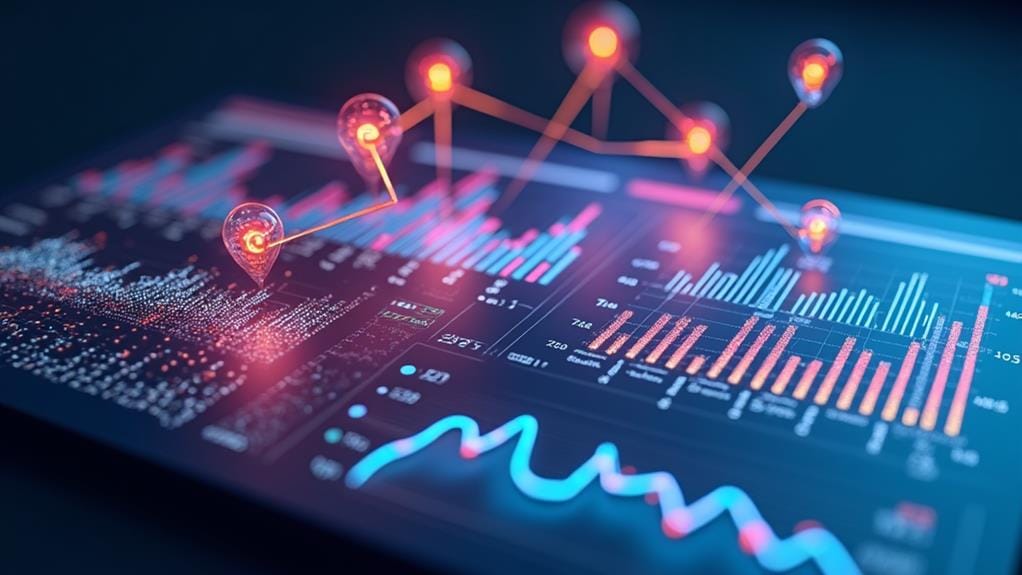

Vous transformerez votre stratégie de médias sociaux en une réussite fondée sur des données, en exploitant les éléments suivants analyse prédictive. Commencez par collecter des données complètes à l'aide d'outils tels que Google Analytics[1] et Facebook[2] Des idées pour comprendre les modèles de comportement des utilisateurs. Algorithmes d'apprentissage automatique peut alors identifier les connexions cachées et prévoir les tendances futures, vous aidant ainsi à créer un contenu qui trouve un écho auprès de votre public avant même qu'il ne sache qu'il en a besoin. Grâce à Tests A/B et suivi en temps réelAvec l'aide d'un logiciel de gestion de contenu, vous pouvez augmenter les taux d'engagement jusqu'à 30% tout en restant à l'avant-garde des tendances du secteur. Votre approche des médias sociaux basée sur les données révélera des informations puissantes qui révolutionneront votre stratégie de contenu.

Dans le paysage numérique actuel, analyse prédictive est devenue la pierre angulaire d'une marketing des médias sociaux. Vous découvrirez que cette approche puissante combine l'analyse statistique avec algorithmes d'apprentissage automatique pour transformer vos données de médias sociaux en des informations exploitables.
En analysant l'historique du comportement des utilisateurs et modèles d'engagementvous êtes en mesure de prévoir les tendances futures et d'adapter votre stratégie d'entreprise à l'évolution du marché. stratégie de contenu en conséquence. Les des informations sur les clics fournie par l'analyse permet d'identifier les domaines à améliorer et de mettre en évidence ce qui stimule l'engagement.
Considérez l'analyse prédictive comme votre boule de cristal pour le succès des médias sociaux. Vous commencerez par collecter des données à partir de différentes plateformes, en recueillant tout ce qui concerne les likes et les partages, ainsi que les taux de clics.
Ensuite, des algorithmes sophistiqués d'apprentissage automatique se mettent au travail, identifiant des modèles que vous auriez pu manquer et révélant des connexions cachées dans les interactions des utilisateurs. Ces algorithmes, notamment les arbres de décision et les réseaux neuronaux, vous aident à comprendre ce qui fait vibrer votre public.
La beauté de cette approche réside dans sa capacité à anticiper les préférences du public avant qu'elles ne deviennent évidentes. Vous ne vous contentez plus de réagir aux tendances, vous les devancez.
Succès en analyse prédictive s'appuie sur de solides collecte de données et des méthodes d'analyse systématique. Vous devrez tirer parti de puissantes outils d'analyse comme Google[3] Analytics, Facebook Insights et Twitter Analytics pour recueillir des données significatives sur votre engagement dans les médias sociaux. Ces outils constituent la base de la compréhension de votre engagement sur les médias sociaux. comportement du public et de faire des prédictions précises.
Il est essentiel de choisir des outils qui permettent des informations exploitables pour améliorer la prise de décision et optimiser vos stratégies en matière de médias sociaux. Vos préparation des données est impératif - ne sautez pas cette étape ! Vous devez nettoyer et organiser vos données en supprimant les doublons et en traitant les valeurs manquantes. Cela garantit que vos modèles prédictifs travaillent avec des informations fiables.
Combinez vos mesures quantitatives avec des informations qualitatives provenant d'enquêtes et de groupes de discussion pour obtenir une image complète de ce qui fait vibrer votre public. Prêt à approfondir ? C'est là que le l'analyse exploratoire des données entre en jeu. Vous utiliserez outils de visualisation pour repérer des tendances et des modèles qui ne sont pas forcément évidents à première vue.
N'oubliez pas d'évaluer régulièrement vos méthodes de collecte de données afin de ne pas perdre de vue vos objectifs. Au fur et à mesure que les médias sociaux évoluent, vous devrez adapter votre approche pour maintenir des prévisions précises. Considérez cela comme un affinage de votre boule de cristal : plus vos données seront précises, plus votre vision de l'évolution des médias sociaux sera claire. tendances futures.

Créer des outils puissants modèles de prévision nécessite un mélange stratégique des bonnes algorithmes et méticuleux préparation des données. Lorsque vous élaborez des modèles de prévision efficaces, vous devez vous concentrer sur la sélection d'algorithmes parfaits capables de détecter des schémas dans vos données historiques. données sur les médias sociaux.
Les stratégies en matière de médias sociaux peuvent produire un énorme ROI social avec un investissement minimal, ce qui rend analyse prédictive un outil précieux. Votre succès dépend d'une préparation minutieuse des données - nettoyage, transformation et normalisation de vos ensembles de données pour garantir qu'ils sont prêts pour l'analyse.
Voici ce qu'il faut privilégier dans votre démarche d'analyse prédictive :
L'optimisation de la stratégie de contenu moderne s'appuie sur analyse prédictive pour transformer des données brutes en des informations exploitables pour vos campagnes de médias sociaux. En analysant les les mesures historiques de l'engagement et des modèles de comportement des utilisateurs, vous comprendrez clairement quel contenu trouve un écho auprès de votre public et à quel moment il est le plus susceptible de s'y intéresser.
Incorporer engagement en temps réel des stratégies, telles que la réponse rapide aux client[4] renforce les relations avec les clients et la fidélité à la marque.
Vous voudrez adopter segmentation de l'audience est votre arme secrète pour créer un contenu personnalisé qui s'adresse directement à différents groupes d'utilisateurs. Lorsque vous combinez cela avec Tests A/Bvous avez la possibilité d'augmenter l'engagement jusqu'à 30%.
Les outils d'analyse des médias sociaux vous aideront à mettre en évidence les points forts et les points faibles de votre entreprise. heures d'affichage lorsque votre public est le plus actif, augmentant ainsi la visibilité de votre contenu de 50%.
N'oubliez pas de garder un œil sur sujets d'actualité grâce à l'analyse prédictive - c'est votre boule de cristal pour calendriers de contenu. En restant à l'avant-garde des tendances émergentes, vous vous positionnerez comme un leader du secteur plutôt que comme un suiveur.

En s'appuyant sur votre stratégie de contenu optimisée, des suivi des performances constitue l'épine dorsale de l'amélioration continue du marketing des médias sociaux.
En tirant parti de l'analyse prédictive et de la analyse en temps réel vous obtiendrez des informations inestimables sur vos activités. comportement du public et les interactions avec les utilisateurs. Votre succès dépend de la surveillance constante des paramètres clés et de la prise en compte des besoins des utilisateurs. des ajustements fondés sur des données à vos stratégies de contenu.
Pour dynamiser vos efforts de suivi des performances, concentrez-vous sur ces éléments essentiels :
Vous travaillerez avec quatre types d'analyse : l'analyse descriptive montre ce qui s'est passé, l'analyse diagnostique explique pourquoi, l'analyse prédictive prévoit ce qui va se passer, et l'analyse prescriptive vous indique les actions à entreprendre pour obtenir les résultats souhaités.
Vous trouverez l'analyse prédictive dans l'optimisation du contenu pour les recommandations de Netflix, la segmentation de l'audience de Facebook pour les publicités, l'identification des tendances dans les prévisions de vente au détail et la modélisation du comportement qui aide les entreprises à prédire le taux de désabonnement et les modèles d'engagement des clients.
Vous analyserez les médias sociaux à l'aide de mesures d'engagement, d'informations sur l'audience, de l'identification des tendances, de la performance du contenu, de l'analyse des sentiments, de la comparaison des plateformes, de l'impact des influenceurs, de l'optimisation du calendrier, de l'efficacité des campagnes et de la visualisation des données afin de prendre des décisions marketing éclairées.
Comme les anciens oracles, vous utiliserez les prévisions et l'analyse prédictive pour entrevoir l'avenir grâce à l'exploration de données, à l'apprentissage automatique et à l'analyse des séries chronologiques, ce qui vous aidera à prendre des décisions éclairées basées sur les modèles de comportement des consommateurs.